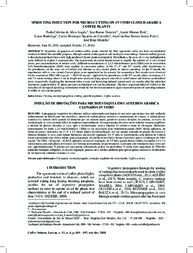Sprouting induction for micro-cutting on in vitro cloned arabica coffee plants.
Sprouting induction for micro-cutting on in vitro cloned arabica coffee plants.
Author(s): ANGELO, P. C. da S.; FERREIRA, I. B.; REIS, A. M.; BARTELEGA, L.; CARVALHO, C. H. S. de; PAIVA, A. C. R. S.; MATIELLO, J. B.
Summary: Vegetative propagation of arabica coffee plants selected by their agronomic value has been accomplished routinely in Brazil for scientific purposes, through somatic embryogenesis and rooting of stem cuttings. Somatic embryogenesis is the election method when a very high number of cloned plants is demanded. Nevertheless, the costs of in vitro multiplication make difficult to explore it commercially. The experiments described herein aimed to amplify the number of in vitro cloned plants, post acclimatization, to reduce costs. Different concentrations of 2,3,5-triiodobenzoic acid (TIBA) and its association with benzylaminopurine (BAP) were applied, as successive pulses, in the 3rd, 8th and 13th months after transference to the greenhouse, on the same set of Catucaí and Siriema in vitro cloned plants, to induce sprouting. At the 8th month, the experiments with in vitro cloned Catucaí plants were reproduced in the nursery, for comparison. Best results were observed for the association TIBA 1000 mg.mL-1 + BAP 60 mg.mL-1 applied in the greenhouse, at the 13th month, when, on average, 8.5 and 7.0 micro-cuttings above 1 cm in length were produced using sprouts taken from each Catucaí and Siriema acclimatized plant, respectively. Applying this treatment twice a year, and harvesting induced sprouts each six months after the induction treatments, approximately 15 plants per each acclimatized one can be produced. The most important effect of TIBA was the induction of sub-apical sprouting. Greenhouse would be the best environment to apply successive pulses of sprouting inducers to coffee in vitro cloned plants.
Publication year: 2018
Types of publication: Journal article
Unit: Embrapa Coffee
Observation
Some of Embrapa's publications are published as ePub files. To read them, use or download one of the following free software options to your computer or mobile device. Android: Google Play Books; IOS: iBooks; Windows and Linux: Calibre.
Access other publications
Access the Agricultural Research Database (BDPA) to consult Embrapa's full library collection and records.
Visit Embrapa Bookstore to purchase books and other publications sold by Embrapa.

